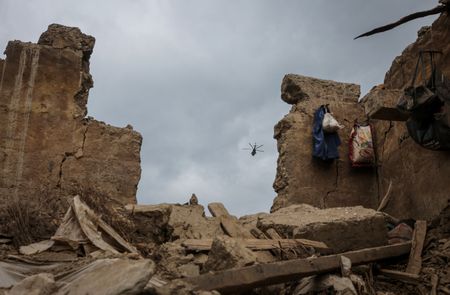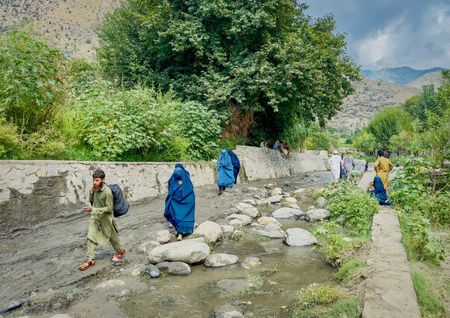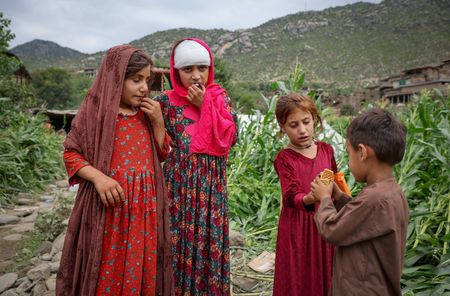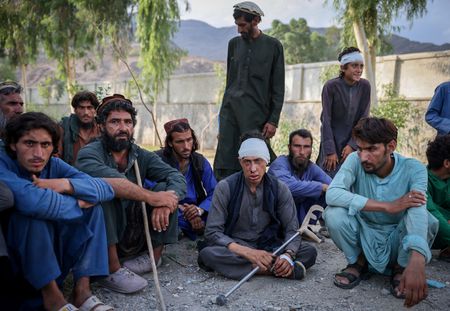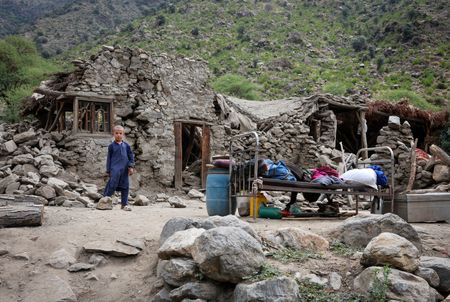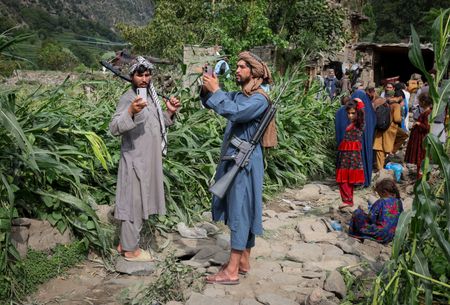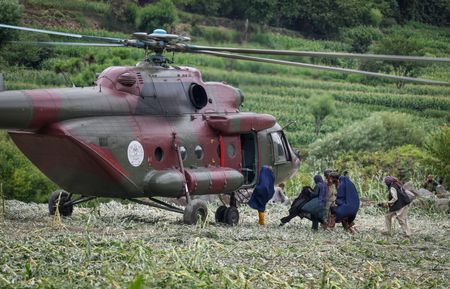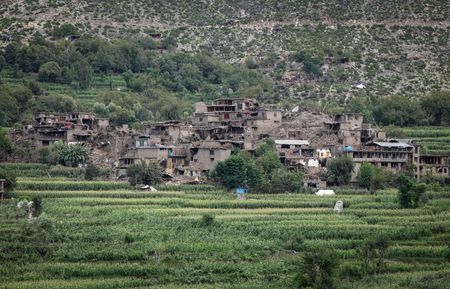By Sayed Hassib and Charlotte Greenfield
KABUL/MAZAR DARA, Afghanistan (Reuters) -Rescue workers on Thursday pulled bodies from the rubble of homes razed in Afghanistan’s earthquakes as the confirmed death toll topped 2,200, while homeless survivors faced a bleak future with global aid agencies warning of dwindling resources.
Search operations continued in the quake-hit mountainous eastern areas, the Taliban administration said, announcing a new death toll of 2,205 with at least 3,640 people injured.
“Everything we had has been destroyed,” said Aalem Jan, whose house in the worst-affected province of Kunar was flattened by the tremors.
“The only remaining things are these clothes on our backs,” said Jan. His family sat under trees with their belongings piled next to them.
The first earthquake of magnitude 6, one of Afghanistan’s deadliest in recent years, unleashed widespread damage and destruction in the provinces of Kunar and Nangarhar on Sunday, when it struck at a shallow depth of 10 km (6 miles).
A second quake of magnitude 5.5 on Tuesday caused panic and interrupted rescue efforts as it sent rocks sliding down mountains and cut off roads to villages in remote areas.
More than 6,700 homes have been destroyed, authorities have said. The United Nations has warned the toll could rise with people still trapped under rubble as time runs out for survivors.
Humanitarian needs are “vast and growing rapidly”, said the International Federation of Red Cross and Red Crescent Societies.
“Up to 84,000 people are directly and indirectly affected, with thousands displaced,” it added, citing initial figures.
In some of the worst-affected villages in Kunar province, two out of three people had been killed or injured, while 98% of buildings were either destroyed or damaged by the tremors, according to an assessment by British-based charity Islamic Relief Worldwide.
Survivors desperately searching for family members sifted rubble, carried bodies on woven stretchers and dug graves with pickaxes in the wait for aid to arrive.
Video showed trucks, some laden with sacks of flour and others carrying men with shovels, travelling to remote villages on higher slopes. Authorities also airdropped dozens of commando forces at sites where helicopters could not land.
Afghanistan is prone to deadly earthquakes, particularly in the Hindu Kush mountain range, where the Indian and Eurasian tectonic plates meet.
With homes made mostly of dry masonry, stone and timber, some families preferred to sit out in the open rather than return home as aftershocks continue at regular intervals.
The houses gave little protection from the quakes, in ground left unstable by days of heavy rain, said the U.N. Office for the Coordination of Humanitarian Affairs.
Resources for rescue and relief work are tight in the South Asian nation of 42 million people pulverised by war, poverty and shrinking aid, where harsh weather presents a further challenge.
U.S. President Donald Trump’s funding cuts to foreign aid and donor frustration over the Taliban’s restrictive policies towards women and its curbs on aid workers have worsened Afghanistan’s isolation.
The World Health Organisation pointed to a funding gap of $3 million, saying it was critical to keep medicines, trauma kits, and essential commodities flowing amid rising demand.
The U.N. World Food Programme has funding and stocks to support the survivors for just four more weeks, its country head, John Aylieff, told Reuters on Wednesday.
Jacopo Caridi of the Norwegian Refugee Council, called for donors to go beyond life-saving relief to ensure Afghans a chance at a future beyond perpetual emergency.
“The earthquake should serve as a stark reminder: Afghanistan cannot be left to face one crisis after another alone,” he said.
(Reporting by Sayed Hassib in Mazar Dara, Mohammad Yunus Yawar in Kabul, Charlotte Greenfield and Saeed Shah in Islamabad; Writing by Sudipto Ganguly; Editing by Clarence Fernandez and Ros Russell)


